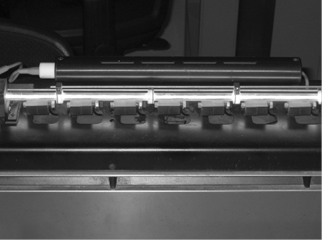
تاريخ الفيزياء

علماء الفيزياء


الفيزياء الكلاسيكية

الميكانيك

الديناميكا الحرارية


الكهربائية والمغناطيسية

الكهربائية

المغناطيسية

الكهرومغناطيسية


علم البصريات

تاريخ علم البصريات

الضوء

مواضيع عامة في علم البصريات

الصوت


الفيزياء الحديثة


النظرية النسبية

النظرية النسبية الخاصة

النظرية النسبية العامة

مواضيع عامة في النظرية النسبية

ميكانيكا الكم

الفيزياء الذرية

الفيزياء الجزيئية


الفيزياء النووية

مواضيع عامة في الفيزياء النووية

النشاط الاشعاعي


فيزياء الحالة الصلبة

الموصلات

أشباه الموصلات

العوازل

مواضيع عامة في الفيزياء الصلبة

فيزياء الجوامد


الليزر

أنواع الليزر

بعض تطبيقات الليزر

مواضيع عامة في الليزر


علم الفلك

تاريخ وعلماء علم الفلك

الثقوب السوداء


المجموعة الشمسية

الشمس

كوكب عطارد

كوكب الزهرة

كوكب الأرض

كوكب المريخ

كوكب المشتري

كوكب زحل

كوكب أورانوس

كوكب نبتون

كوكب بلوتو

القمر

كواكب ومواضيع اخرى

مواضيع عامة في علم الفلك

النجوم

البلازما

الألكترونيات

خواص المادة


الطاقة البديلة

الطاقة الشمسية

مواضيع عامة في الطاقة البديلة

المد والجزر

فيزياء الجسيمات


الفيزياء والعلوم الأخرى

الفيزياء الكيميائية

الفيزياء الرياضية

الفيزياء الحيوية

الفيزياء العامة


مواضيع عامة في الفيزياء

تجارب فيزيائية

مصطلحات وتعاريف فيزيائية

وحدات القياس الفيزيائية

طرائف الفيزياء

مواضيع اخرى
OPTICS AND CAVITIES
المؤلف:
Mark Csele
المصدر:
FUNDAMENTALS OF LIGHT SOURCES AND LASERS
الجزء والصفحة:
p237
23-3-2016
2001
OPTICS AND CAVITIES
Most commercial HeNe laser tubes are of a one-piece design featuring integral mirrors resembling. This compact design has prealigned optics providing trouble-free operation for most users. Optics never require cleaning or realignment since they are sealed into the tube. Whereas in older tubes, mirrors affixed to the glass tube by epoxy were aligned with a simple lateral motion, such mirrors have been abandoned in favor of hard-sealed optics in which adjustment is provided during manufacture by flexing a metal tube between the optic and the tube. Most one-piece tubes are randomly polarized, although some tubes have integral Brewster windows within the tube itself, designed solely to polarize the output beam.
Some lasers, primarily research and lab lasers, feature external optics. Tubes often have Brewster windows to reduce loss, but an alternative is a plane window with antireflective coatings. These coatings are required since losses of up to 8% at an uncoated window would certainly prevent oscillation. Some long (up to 1 m) research lasers also feature wavelength selectors allowing tuning of the laser over multiple wavelengths. These selectors are prisms with an affixed HR and allow tuning by changing the angle of the assembly with respect to the tube axis. Shorter lasers lack the necessary gain to overcome losses imposed by the wavelength selector, so usually lack these features.
Regardless of the type of optics employed (either internal or external), mirrors for use in a visible HeNe laser must be designed to absorb (or transmit) strongly at 3.39 μm to induce a large loss at that wavelength and hence suppress the strong IR transition there. This transition has extremely high gain which will, if allowed to oscillate, rob power from all other transitions and stop most from oscillating. For this reason, many HeNe lasers that have external optics use borosilicate glass plasma tube windows instead of quartz since borosilicate absorbs a good deal of IR energy. In long tubes (e.g., 1 m) even the use of borosilicate windows may not prevent oscillation of this IR line, in which case magnets are placed along the length of the tube to suppress the transition (by inducing Zeeman splitting of the transition). In Figure 1.1, magnets of this type are located under the plasma tube. Also evident

Figure 1.1. Magnets to suppress the 3.39-μm IR transition.
are two bare metal rods traversing the length of the laser, which are used to help ignite the plasma on this very long (>1 m) laser. Even in a relatively short HeNe laser, suppression of the IR line (by cavity optics) may lead to significant power increases in the visible transitions.















 قسم الشؤون الفكرية يصدر مجموعة قصصية بعنوان (قلوب بلا مأوى)
قسم الشؤون الفكرية يصدر مجموعة قصصية بعنوان (قلوب بلا مأوى) قسم الشؤون الفكرية يصدر مجموعة قصصية بعنوان (قلوب بلا مأوى)
قسم الشؤون الفكرية يصدر مجموعة قصصية بعنوان (قلوب بلا مأوى) قسم الشؤون الفكرية يصدر كتاب (سر الرضا) ضمن سلسلة (نمط الحياة)
قسم الشؤون الفكرية يصدر كتاب (سر الرضا) ضمن سلسلة (نمط الحياة)

















